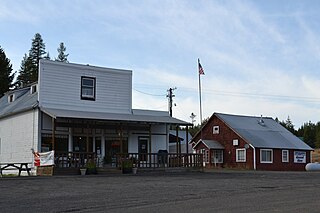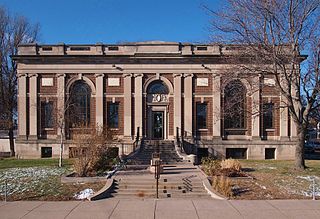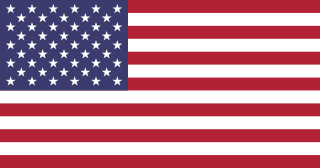
Umatilla County is a county located in the U.S. state of Oregon. As of the 2010 census, the population was 75,889. The county seat is Pendleton, but the largest city is Hermiston. The county is named for the Umatilla River.

The Tamástslikt Cultural Institute is a museum and research institute located on the Umatilla Indian Reservation near Pendleton in eastern Oregon. It is the only Native American museum along the Oregon Trail. The institute is dedicated to the culture of the Cayuse, Umatilla, and Walla Walla tribes of Native Americans. The main permanent exhibition of the museum provides a history of the culture of three tribes, and of the reservation itself. The museum also has a second hall for temporary exhibitions of specific types of Native American art, craftwork, history, and folklore related to the tribes.
A Carnegie Library is a library built with money donated by Scottish-American businessman and philanthropist Andrew Carnegie.

Meacham is an unincorporated community in Umatilla County, Oregon. It is located on the old alignment of U.S. Route 30 off Interstate 84, in the Umatilla National Forest, near Emigrant Springs State Heritage Area and the route of the Oregon Trail. It is part of the Pendleton–Hermiston Micropolitan Statistical Area.

The Dalles Carnegie Library is a historic former library building located in The Dalles, Oregon, United States. It is one of the thousands of libraries whose construction was funded by Andrew Carnegie. The construction grant of $10,000 was approved in March 1907, and it was dedicated in September 1910.

The Oregon Public Library is located in Oregon, Illinois, United States, the county seat of Ogle County. The building is a public library that was constructed in 1909. Prior to 1909, Oregon's library was housed in different buildings, none of which were designed to house a library. The library was built using a grant from wealthy philanthropist Andrew Carnegie. The grant was obtained after Oregon's citizens voted to change Oregon's library from a city library to a township library. The building was completed by 1908 but the library did not begin operation until 1909.

The Carnegie Center for Art & History, within the Downtown Historic District of New Albany, Indiana, is a contemporary art gallery and local history museum. The building was initially built as a Carnegie Library, first opened on March 2, 1904, with 11,125 total books. It is of Beaux-Arts architecture style. It was used as a library until 1969, when the new New Albany-Floyd County Public Library was built. After a $1.2 million renovation in 1998, the name was changed to the Carnegie Center for Art & History to better reflect its mission and library heritage. In 2015, total attendance was 26,690 and Carnegie Center staff presented 107 programs to participants of all ages. The Carnegie Center has a full-time staff of four employees, which includes a Director, Curator, Coordinator of Public Programming and Outreach and First Impression Receptionist and a part-time maintenance person. Three part-time trained volunteers come in weekly to manage a collection of over 5,000 objects. All exhibits and programs are offered free of charge to the public.

The Arlington Hills Library is a 1916 Beaux Arts library building designed by Cameron and Company. It is one of three Carnegie Libraries in Saint Paul, Minnesota, United States. It is listed on the National Register of Historic Places.

Franklin Library is a public library on Franklin Avenue in Minneapolis, Minnesota, United States. The library was one of thirteen branch libraries established under the leadership of Gratia Countryman, the chief librarian of the Minneapolis Public Library from 1904 to 1936. The library housed the largest collection of Scandinavian books, newspapers, and magazines within the system, which reflected the population living in the area. The library was funded by the Carnegie Corporation and designed by Edward Lippincott Tilton, a New York City architect.

The Monongalia Arts Center, or MAC, is located in Morgantown, West Virginia near the campus of West Virginia University. The MAC opened to the public in 1978 as a non-profit arts and culture center, which it remains today. The MAC's mission is "to provide a home for the arts where the work of visual and performing artists is showcased and interest in the arts is nurtured through ongoing educational programs." The building hosts two galleries, a theatre for the performing arts, and is undergoing production on other projects, including an Internet radio station and the establishment of the Tanner Theatre as a regular venue for touring bands. The building is also recognized on the National Register of Historic Places.

The John F. Kilkenny United States Post Office and Courthouse, formerly the United States Post Office and Courthouse is a post office and a courthouse of the United States District Court for the District of Oregon, located in Pendleton, Oregon. Completed in 1916 under the supervision of architect Oscar Wenderoth, the building was listed on the National Register of Historic Places in 1985. In 1984, the United States Congress renamed the building for John Kilkenny, a former judge of the District of Oregon and of the United States Court of Appeals for the Ninth Circuit.

The Bowman Hotel is a historic three story brick hotel building located in Pendleton, Oregon, United States. The hotel was built in 1906 by Purl Bowman (1862–1939), part of a prominent pioneer family in Pendleton. The family lived near lower Birch Creek, Oregon; Bowman was a successful farmer and wool producer. He bought the hotel property in 1900 of a house on the site burned down. His cousin Walter S. Bowman was a prominent professional photographer in Pendleton. The hotel was added to the National Register of Historic Places on November 6, 1980.

The Masonic Temple in Pendleton, Oregon is a historic building constructed in 1887. It was originally built as a meeting hall for Pendleton Lodge, with commercial space on the ground floor to help offset the cost of maintaining the meeting hall. It was listed on the listed on the National Register of Historic Places in 1982. Since its listing, the lodge had moved to a new building.

St. Peter's Roman Catholic Church is a historic church building in Echo, Oregon, United States. The church was built by the Portuguese immigrant community in Echo.

The Fletcher Free Library is the public library serving Burlington, Vermont. It is located at 235 College Street, in an architecturally distinguished Beaux-Arts building, constructed in 1902 with funding support from philanthropist Andrew Carnegie. The building was listed on the National Register of Historic Places in 1976.

The Carnegie Center for Arts and History is a museum and events venue in downtown Jackson, Tennessee, housed in the former Jackson Free Library.

The Corvallis Arts Center is a nonprofit organization whose stated mission includes conducting an array of "diverse exhibitions and cultural events" and providing the Corvallis, Oregon community with outreach and educational services relating to the arts. The center offers an ongoing series of art classes and camps, with a particular focus on the needs of at-risk youth. More than a dozen teaching artists working in a range of mediums conduct classes, exhibits, and demonstrations in connection with the center's work.



























